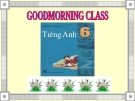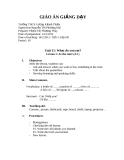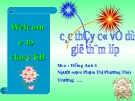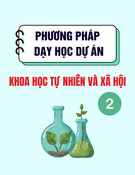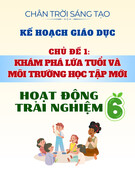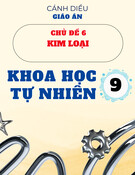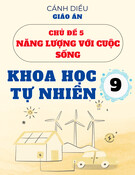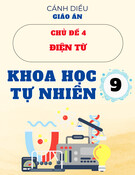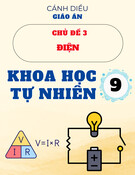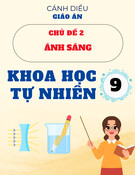
Tröôøng PTDT Noäi truù Kroâng Paéc – Giaùo aùn Tieáng Anh lôùp 6
Date of planning:
Date of teaching:
Period: 1
Week: 1
LÀM QUEN V I MÔN H C VÀ CÁCH H CỚ Ọ Ọ
I. M C TIÊU MÔN H C:Ụ Ọ
1. C s :ơ ở
- Do B Giáo D c và Đào T o qui đ nh.ộ ụ ạ ị
- T o đi u ki n hoà nh p v i c ng đ ng Qu c T và khu v c.ạ ề ệ ậ ớ ộ ồ ố ế ự
2. M c tiêu chung:ụ
- Hình thành và phát tri n h c sinh nh ng ki n th c, k năng c b n v Ti ng Anh và nh ngể ở ọ ữ ế ứ ỹ ơ ả ề ế ữ
ph m ch t trí tu c n thi t đ ti p t c h c ho c đi vào cu c s ng lao đ ng.ẩ ấ ệ ầ ế ể ế ụ ọ ặ ộ ố ộ
3. M c tiêu c th :ụ ụ ể
- H c xong THCs, h c sinh đ t đ c nh ng yêu c u ch y u sau:ọ ọ ạ ượ ữ ầ ủ ế
+ N m đ c ki n th c c b n, t i thi u và t ng đ i h th ng v Ti ng Anh, th c hành hi nắ ượ ế ứ ơ ả ố ể ươ ố ệ ố ề ế ự ệ
đ i, phù h p l a tu i.ạ ợ ứ ổ
+ Có s hi u bi t khái quát v văn hoá c a các n c s d ng Ti ng Anh.ự ể ế ề ủ ướ ử ụ ế
+ Giao ti p đ n gi n d i d ng: nghe – nói - đ c - vi t.ế ơ ả ướ ạ ọ ế
II. N I DUNG MÔN H C:Ộ Ọ
Xoay quanh 6 ch đi m l nủ ể ớ :
- Các v n đ thu c v cá nhân (You and me)ấ ề ộ ề
- Các v n đ v h c t p và giáo d c (Education)ấ ề ề ọ ậ ụ
- C ng đ ng (Community)ộ ồ
- S c kho (Health)ứ ẻ
- Vui ch i gi i trí (Recreation)ơ ả
- Th gi i quanh ta (The world around us)ế ớ
III. PHÂN PH I CH NG TRÌNH:Ố ƯƠ
G m: 105 ti t d y trong 35 tu n.ồ ế ạ ầ
HKI: 3 ti t x 18 tu n = 54 ti t h cế ầ ế ọ
HKII: 3 ti t x 17 tu n = 51 ti t h cế ấ ế ọ
Có 16 đ n v bài h c trong c nămơ ị ọ ả
HKI: 8 bài (t bài 1 -> bài 8)ừ
HKII: 8 bài (t bài 9 -> bài 16)ừ
Giaùo vieân : Y Khöông Nieâ Kdaêm 1

Tröôøng PTDT Noäi truù Kroâng Paéc – Giaùo aùn Tieáng Anh lôùp 6
Date of planning:
Date of teaching:
Period: 2
Week: 1
Unit 1: GREETINGS
Section A: -Hello (1, 2, 3, 4)
I- Objectives:
- Teach students how to greet , to introduce their own names.
- Teach students how to greet one another.
- Developing: four skills.
II- Language content:
- Vocabulary: Hello, Hi, I, am, is, name, my
- Structures:
+ Hello / Hi
+ My name is …
+ I am …
III- Teaching aids:
- Pictures
- Text book (English for Vietnam grade)
- Cassette tapes
IV- Procedures:
1. Warm up:
Teacher’s work Students’ work Content
- Ask students some questions in
Vietnamese about saying when they
meet a new person
Individually
2. Presentation:
- Ask students how to introduce
themselves when they meet a new
person
1- Introduce the situation
- Ask students to listen the words
Hello , Hi
- Ask students to listen again then
repeat
- Correct their pronunciation
2- Ask students to practice greeting one
another in turns of two.
- Go around the class and correct their
pronunciation
In chorus
Pair work
Group work
New words:
- Hello
- Hi
- I
- my
- name
- am
- is
- are
Eg:
. I am Lan.
. My name is Lan.
3. Practice:
- Ask students to listen again then Pair work - Hi
Giaùo vieân : Y Khöông Nieâ Kdaêm 2

Tröôøng PTDT Noäi truù Kroâng Paéc – Giaùo aùn Tieáng Anh lôùp 6
repeat.
- Ask students to read in pairs.
- Tell students the ways to introduce
their names.
- Ask students to listen part 3 on page
11.
- Ask some students to read before
class
- Correct their pronunciation.
- Ask students to practice with a group
of four.
- Ask students to introduce their names
one by one.
- Correct their pronunciation.
Group work
Group work
Individually
- Hello
- I am (I’m) …
- My name is (my name’s) …
Eg:
A: Hello, I am …
(My name is …)
B: Hi, I am …
(My name is …)
4. Consolidation:
- T. asks Ss to introduce their name to the class.
- T. calls on one or two of the Ss to role play in front of the class.
5. Homework:
- Learn the new words by heart.
- Prepare “Unit 1. (cont.) A. Hello (5, 6, 7, 8)” for the next time.
Date of planning:
Date of teaching:
Period: 3
Week: 1
Unit 1: GREETINGS
Section A: -Hello ( A 5, 6, 7, 8)
I- Objectives:
- Teach students how to greet one another.
- Developing: four skills.
II- Language content:
Grammar:
-Vocabulary: fine, thanks, how, are, you
-Structures:
+ My name’s Lan or I’m Lan.
+ How are you? -> I’m fine, thanks.
III- Teaching aids
-Pictures, text book, cassette tapes.
IV- Procedure
1. Warm up:
Teacher’s work Students’ work Content
- Ask some students to introduce their Individually - WOH = how
Giaùo vieân : Y Khöông Nieâ Kdaêm 3

Tröôøng PTDT Noäi truù Kroâng Paéc – Giaùo aùn Tieáng Anh lôùp 6
names
- Ask some students play “Jumble
words”
Play
- MANE = name
- YM = my
2. Presentation:
- Sticks the picture A5 (page 12)
- Introduce the dialogue.
- Plays the tape for the Ss.
- Read the dialogue then ask students
to repeat in chorus
- Introduce the structure
- Ask students to listen the dialogue
again
In chorus
In pair
New word:
- fine (adj)
- thanks
Structures:
+ How are you?
+ I’m fine, thanks.
And you?
3. Practice:
- Ask students to practice reading the
dialogue in pairs.
- Ask some pairs to read before the
class.
- Ask students to practice with a
partner.
- Ask students to look at the pictures
hanging on the board.
- Ask students to make the similar
dialogues in pairs.
- Explain the words: Mr, Mrs, Miss.
- Call on some pairs to practice before
the class.
- Correct their pronunciation.
Group work
In pair
In pair
In pair
Eg:
A: Hello, Miss Hoa.
B: Hi, Mr. H ng.ư
How are you?
A: I’m fine, thanks.
And you?
B: Fine, thanks.
* Write:
Nam: Hello, ….
How are you?
Lan: Hi, I’m ….
4. Consolidation:
-T. calls on one or two of the Ss to role _ play in front of the class.
5. Homework:
- Ask students to look at the dialogue in part 7 on page 13 then complete it.
- Ask students to compare with their partners.
- Ask students to write in their exercises book.
- Prepare “Unit 1. (cont.) B. Good morning” for the next time.
Date of planning:
Giaùo vieân : Y Khöông Nieâ Kdaêm 4

Tröôøng PTDT Noäi truù Kroâng Paéc – Giaùo aùn Tieáng Anh lôùp 6
Date of teaching:
Period: 4
Week : 2
Unit 1: GREETINGS
Section B: Good morning
I- Objectives:
- Teach students how to greet in different time of the day.
- Teach students how to say good bye.
- Developing: four skills.
II- Language content:
Grammar:
-Vocabulary: good, morning, afternoon, evening, night, children, mom, bye
III- Teaching aids
-Pictures, text book, cassette tapes.
IV- Procedure
1. Warm up:
Teacher’s work Students’ work Content
- Ask students to repeat the ways of
greeting.
- Stick a picture on the board and ask
students to guess when of the day it
is.
Individually
2. Presentation:
- Introduce the ways of greeting of
the day.
- Ask students to listen twice or three
times
- Ask students to repeat
- Ask students to read before the class
Individually 1. Listen and repeat:
New words:
- Children (n): trẻ
- Mom (n): m , máẹ
- Good morning: 6 a.m 12 a.m
- Good afternoon: 12p.m 6p.m
- Good evening: 6p.m 12 p.m
- Good bye/ bye
- Good night
3. Practice:
- Ask students to practice with their
partners.
- Ask students to practice in pairs
- Give them different situations and
ask them to practice
- Ask students to listen to the
dialogue in B3 twice
- Ask students to repeat in chorus
- Ask students to tell the time of the
dialogue
In pair
In chorus
2. Practice with a partner:
Good morning
afternoon
evening
night
4. Write:
Giaùo vieân : Y Khöông Nieâ Kdaêm 5


